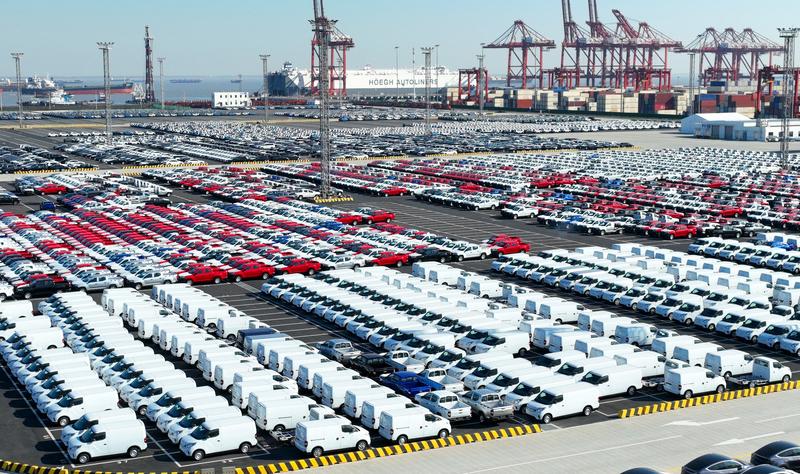 This undated file photo shows skyscrapers in the central business district in Shenzhen, Guangdong province. (PHOTO PROVIDED TO CHINA DAILY)
This undated file photo shows skyscrapers in the central business district in Shenzhen, Guangdong province. (PHOTO PROVIDED TO CHINA DAILY)
At least eight provincial-level regions in China saw their total GDP exceed 5 trillion yuan ($737 billion) in 2022, with both Guangdong and Jiangsu provinces reaching over 12 trillion yuan, according to provincial government data.
The figures have once again proved the resilience of China's economy — the world's second-largest — and show potential for growth, analysts and company executives said.
While multiple cyclical and structural headwinds — from a gloomy global outlook to China's weak property market — may weigh on the country's near-term outlook, macro policy easing will help stabilize the economy, with targeted property sector support, relief measures for households and infrastructure spending being the preferred policy tools, they said.
Guangdong's total GDP is the nation's largest for the 34th consecutive year. Official data show that last year, its GDP came in at over 12.9 trillion yuan, up by 1.9 percent year-on-year
Local statistics authorities nationwide are revealing their GDP figures for 2022, following the National Bureau of Statistics'announcement of last year's national GDP, which grew by 3 percent, last week.
Guangdong's total GDP is the nation's largest for the 34th consecutive year. Official data show that last year, its GDP came in at over 12.9 trillion yuan, up by 1.9 percent year-on-year.
ALSO READ: Chinese firms' role in global economy bigger
Peng Peng, executive chairman at the Guangdong Society of Reform, a think tank, said that conventionally, the service sector played a major role in Guangdong's economic growth. Though the sector underperformed last year mainly due to the evolving COVID-19 situation, he expected a rebound in the industry this year, which will drive local economic vitality.
Jiangsu had the nation's second-highest total GDP, reaching 12.29 trillion yuan in 2022. The province accounted for about 10.2 percent of China's overall economy and has been an anchor of national growth.
 A batch of cars and excavators for export to the European market are seen at the foreign trade car terminal yard of Taicang Port in Jiangsu province in December. (JI HAIXIN / FOR CHINA DAILY)
A batch of cars and excavators for export to the European market are seen at the foreign trade car terminal yard of Taicang Port in Jiangsu province in December. (JI HAIXIN / FOR CHINA DAILY)
When it comes to the growth rate, Fujian and Jiangxi provinces tied for first place, with both reaching 4.7 percent year-on-year.
Jiangsu had the nation's second-highest total GDP, reaching 12.29 trillion yuan in 2022. The province accounted for about 10.2 percent of China's overall economy and has been an anchor of national growth
Ding Changfa, associate professor of economics at Xiamen University, said that Fujian saw success mainly because its economic activity was less severely impacted by the epidemic. The prominent growth of the new energy industry and new economy notably catalyzed overall growth in Fujian. In addition, he said the province's outstanding coastal port resources have made it possible to develop industries such as petroleum refining and chemical industry, making its industrial structure more balanced.
ALSO READ: Chinese economy eyes reform, opening-up and turnaround in 2023
Ten provincial-level regions saw growth of more than 4 percent last year — Fujian, Jiangxi, Hunan, Gansu, Shanxi, Hubei, Shaanxi and Yunnan provinces, and the Inner Mongolia and Ningxia Hui autonomous regions.
Zhou Maohua, an analyst at China Everbright Bank, said that these regions have prioritized the expansion of domestic demand, with more efforts to be made this year to spur consumption, continuously deepen reforms, accelerate industrial upgrading and promote high-quality development.
China's provinces, autonomous regions and municipalities have set their growth targets for this year within a range of 4 to 9.5 percent, with most around 6 percent
In fact, the provincial governments are optimistic about this year, as they expect a gradual recovery in domestic activity.
China's provinces, autonomous regions and municipalities have set their growth targets for this year within a range of 4 to 9.5 percent, with most around 6 percent.
The top four provinces in terms of economic volume last year were Guangdong, Jiangsu, Shandong and Zhejiang. This year, Guangdong, Shandong and Zhejiang have set their growth targets at above 5 percent, while Jiangsu is seeking a rate at around 5 percent.
Kang Yi, chief of the National Bureau of Statistics, said China's economy this year is bound to see an overall improvement, adding that economic activity is gradually normalizing as the country enters a new phase of COVID-19 control
China will likely post above 5 percent economic growth in 2023 due to the further implementation of optimized COVID-19 control measures and a package of stimulus policies that are taking effect gradually, Zhou added.
READ MORE: Chinese economy set to deliver steady recovery in 2023
Kang Yi, chief of the National Bureau of Statistics, said China's economic performance remained stable last year despite many challenges both at home and abroad.
Kang said China's economy this year is bound to see an overall improvement, adding that economic activity is gradually normalizing as the country enters a new phase of COVID-19 control.


